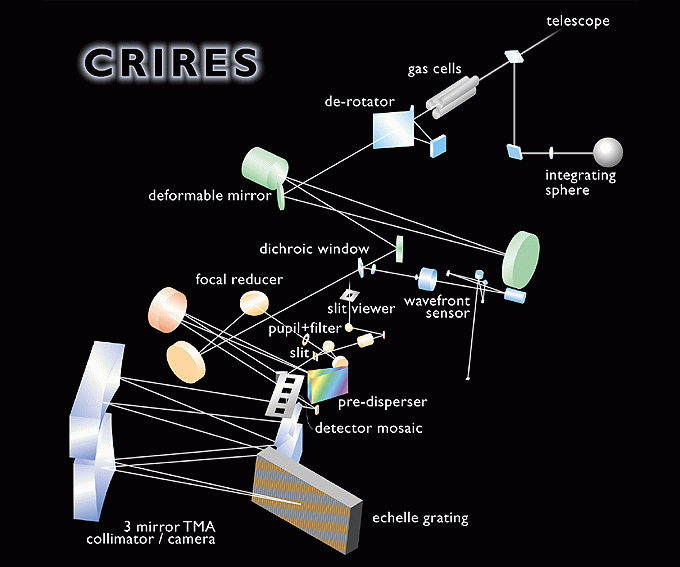CRIRES
|
|||||||

Click
on the image for a full sized display
|
|||
|
Instrument Name |
CRIRES |
|
ESO Responsible |
|
|
Instrument Scientist |
|
|
Location |
Nasmyth UT1 (ANTU) |
|
Status |
Commissioning |
|
Science Team |
B. Gustafsson, C. de Bergh, A. Hatzes, K. Hinkle, E. van Dishoeck |
|
|||
CRIRES first commissioning was successfully performed in June 2006.
First light images and spectra and more information is available : HERE
A second and third commissioning is scheduled in August and October 2006.
Our goal is to be able to release the instrument for the next call for proposals.
|
|||
 The science verification (SV) for CRIRES is carried out following the: VLT
Science Verification Policy and Procedures .
The science verification (SV) for CRIRES is carried out following the: VLT
Science Verification Policy and Procedures .
|
|
|||
A cryogenic high-resolution IR spectrograph has been conceived for the VLT in order to exploit the enormously enhanced sensitivity provided by a dispersive instrument with a large detector array at an 8 m telescope. The gain entails a quantitative and qualitative improvement of the observational capabilities. It can boost all scientific applications aiming at fainter objects, higher spatial (extended sources), spectral and temporal resolution.
The IR spectrograph will make previously inaccessible phenomena and objects available for spectroscopic studies. Table 1 presents a list of science objectives.
|
Extra-Solar Planets |
|
|---|---|
|
Radial velocities studies |
|
|
Direct spectroscopic detection and characterization: CO, CH4. |
|
|
|
|
|
Solar System |
|
|
Chemistry/phys. conditions/velocity fields/structure |
|
|
Giant planets/Titan |
H3+, CH4, NH3, CH3D, AsH3, H2O,C2H2,C2H6, PH3, CH3, NH3, HCN, C2H2, C2H6, PH3, CH3, NH3, HCN |
|
Terrestrial planets |
CO, HCL, HF, HDO, H2O, OCS |
|
Io |
spatial/time mapping of volcanic activity (SO2) |
|
Pluto/Charon/Triton |
search tenous CO, CH4 atmos. |
|
Comets |
(resolve nuclei), H2O abundance, temperature, velocities, minor species. |
|
|
|
|
Stars |
|
|
Stellar evolution/nucleosynthesis (OB, AGB stars, cluster red giants, cool MS, C & S stars in galaxy, S/LMC, nearby glaxies), CNO isotopic abundances unique in IR. |
|
|
Stellar mass:atom/mol. lines from secondaries |
|
|
Stellar winds/mass loss, OB, WR, AGB stars in galaxy and S/LMC, CO,SiO,C2H2, HCN |
|
|
Atmospheric structure & oscillations in cool stars |
|
|
Magnetic fields |
|
|
|
|
|
Star Formation Regions/ISM |
|
|
Accretion/Outflow from embedded YSOs |
|
|
ISM chemistry/ cloud structure, H3+, H2O, CH4, C2H2, NH3 |
|
|
|
|
|
Extragalactic |
|
|
AGN |
Velocity structure of BLR, NLR, CLR & molecular clouds, H recombination, [FeII], [SiIV], H2 lines suffering low dust extinction |
|
|||
The cryogenic echelle will provide for:
high-resolution spectroscopy in
the 1-5 µm range
at the VLT. This instrument employs
the largest available grating for a
spectral resolving power of >=
100,000
with a 0.2 arcsec slit. Simultaneous spectral
coverage is maximized through one or several large (1024 x 1024
pixel) detector arrays in the focal plane. The second array
dimension is exploited for
1-dimensional spectral imaging
along the ~ 50 arcsec slit
Adaptive Optics
to maximise SNR and spatial
resolution.
Functionally, the instrument can be divided into four units. The fore-optics section provides for field de-rotation, cold pupil and field stops, curvature sensing adaptive optics, and slit viewing. The prism predisperser isolates one echelle order and minimizes the total amount of light entering into the high-resolution section. The high-resolution section comprises the collimator, the echelle which is tilt-tuned for wavelength selection, the camera providing the 0.1 arcsec/pixel plate scale, and the detector(s). The calibration unit outside the cryogenic environment contains light sources for flux/wavelength calibration and detector flatfielding.
Observational capabilities and predicted performance are given in Tables 2 and 3.
Table 2: Cryogenic Echelle Main Characteristics
|
Parameter |
Value |
|---|---|
|
Focus |
Nasmyth |
|
Configuration |
stationary |
|
Wavelenght range |
1-5 µm |
|
Slit width-res. power product |
20,000-40,000 (Rmax = 100.000) |
|
Echelle |
40 cm length, 31.6 lines/mm |
|
Optics |
reflective |
|
Detector |
3 x 1024 x 1024 InSb arrays |
|
Pixel size |
0.1 arcsec |
|
Spectral format |
single order |
|
Slit length |
~ 50" |
|
Operating temperature |
60-80 °K |
|
Detector temperature |
~30 °K |
|
background subtraction |
nodding |
|
Istantaneous wavelength coverage |
lambda/70 |
Table 3: Performance Limits
|
Limiting magnitudes ( for S/N = 3 in 1 hr) |
||||||
|---|---|---|---|---|---|---|
|
Wavelength (µm) |
1.2 |
1.6 |
2.2 |
3.3 |
4.2 |
4.7 |
|
mag |
17 |
16.5 |
16 |
13.5 |
12.5 |
11 |
|
Integration times (required for S/N=100 on a 5th mag. star) |
||||||
|
Wavelength (µm) |
1.2 |
1.6 |
2.2 |
3.3 |
4.2 |
4.7 |
|
T [sec], mag=5 |
< 5 |
5 |
10 |
10 |
15 |
30 |
|
Send
comments to Ralf Siebenmorgen |
|||